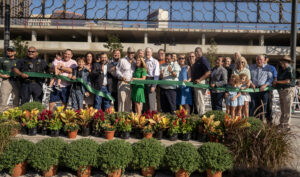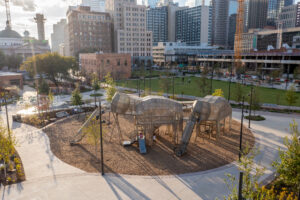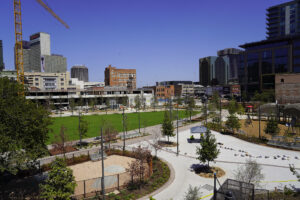This is the third of three blogs in our Monumental Mammoths series about the Harwood Park playground, which features giant sculptural play elements and educational information related to Columbian mammoths, which roamed North Texas about 100,000 years ago. We recently interviewed Dr. Ron Tykoski, the Director of Paleontology and Curator of Vertebrate Paleontology at the Perot Museum of Nature and Science in Dallas, about the mammoths and their way of life. This conversation has been edited for clarity. Learn more about the playground features here, and about Harwood Park and all its amenities. Harwood Park – and the playground – is scheduled to open in spring 2023.
Previously: Find out how the Columbian mammoths size up compared to some Downtown Dallas icons. Plus, learn more about the array of species that roamed the North Texas landscape. Learn more.
Between the time the mammoths became extinct and now (present day), were there any defining characteristics or events that continued to help shape the North Texas environment?
Most Columbian mammoths went extinct around 9,000 to 12,000 years ago. This coincided with when the most recent glacial maximum rapidly ended, the planet warmed, and environments across the northern hemisphere underwent dramatic changes in response to that climatic shift. The last glacial maximum around 22,000 years ago was the most recent time during the Last Glacial Period (about 11,700 to 115,000 years ago) when ice sheets were at their greatest extent and covered much of North America, Northern Europe and Asia.
The North Texas region saw increased drying and warming, with many areas that had once been a patchwork of grassy park-like spaces and thick wooded patches transformed. The wooded areas shrank, the grasslands grew, and eventually large swatches of the region changed to tallgrass prairies, with a couple of belts of thick timber on sandier soils that weren’t as clay-rich and conducive to prairie development. The animals that survived this dramatic shift in environments were those adaptable species still here when the first Europeans entered the region in the 1500s and later.
Over the past couple of hundred years, the landscape underwent changes as dramatic as at the end of the last glacial maximum. Stretches of forest were cut for timber, the prairies plowed under for farms, fences put up to contain cattle, settlements were built and grew into cities, and many of the larger animals viewed as threats or competition to livestock (wolves, black bear, Puma, Bison) were eradicated from most of Texas. Today we share the region with plants and animals that are puny (both in physical stature as well as diversity) remnants of what once lived here.
You mentioned the design of the Harwood Park playground is something that isn’t seen very often. What is the impact of unique learning environments like this on visitors?
The “tip of the hat” to the prehistory of the Dallas area is a different and, as far as I know, unique aspect of this playscape and park. Very few residents of Dallas today have any idea or knowledge of the amazing paleontological past that has been unearthed right beneath their feet as they work, play and live in the Downtown area.
I suspect many first-time visitors to the park will miss the mammoth theme of the playscape. They will assume the playscape is meant to look like ordinary elephants, “just because.” I mean, who doesn’t like elephants? Kids sure do. It will be interesting to see how the park designers capture the attention of visitors enough to tell them, “Hey, these are mammoths, and the reason is because these behemoths used to live right here!” I think kids will actually notice that more easily than the adults will. It will add a layer of excitement to the play and interaction that will happen.
Ultimately, one hopes such a cool story sticks in those young and developing minds, planting the kernel of comprehension in those minds that the world is a much bigger place that’s been here for far longer than we have, and that there’s a history (and prehistory) to be learned beyond the here and now.
The Perot Museum is focused on inspiring minds through nature and science, and this playscape in Harwood Park is a great combination of those two elements. Do you see additional opportunities throughout Dallas to further educate through public spaces?
More and more we live in a world where people, even out in public spaces, can’t seem to pull their eyes off a 4- to 6-inch screen a few inches from their nose. Entities like museums that try to educate and inspire people find themselves competing for attention with 24/7, hand-held connectivity.
However, museums have something the internet and hand-held devices don’t – the Real Thing. There’s a massive gulf of difference between what a person remembers from an 6-inch image on a phone, versus staring up at a 13 foot-tall Columbian mammoth skeleton with 10-foot long tusks curling out from its face, and really feel a sense of awe and wonder.
Public spaces have the chance to provide a bit of that Real Thing, too. Not every public space can or should be a museum, but it still has the power of the outdoors, and the power of location. Those assets provide a chance to make an immediate and local connection to their community’s past – be it historic or prehistoric. They provide a chance to connect to nature, sometimes the only connection to nature for some urban residents.
This potential to connect to the natural world is an especially powerful draw for children, who are often more curious about that world when it is right in front of them within reach. Combine that with a child’s unbridled urge to run, play, and make-believe, and a space like the mammoth-themed playscape in Harwood Park has great potential for Dallas residents.
About Dr. Ron Tykoski
Dr. Ron Tykoski is the Director of Paleontology and Curator of Vertebrate Paleontology at the Perot Museum of Nature and Science in Dallas. Dr. Tykoski holds a Ph.D. in Geological Sciences from The University of Texas at Austin; a Master of Science in Geological Sciences from The University of Texas at Austin; and a Bachelor of Science in Geological Sciences from The University of Michigan – Ann Arbor. After finishing his Ph.D., he started at the Dallas Museum of Natural History as its Fossil Preparator, and continued there as the museum evolved into the current Perot Museum of Nature and Science. He’s worked on and even helped name various predatory dinosaurs, plant-eating dinosaurs, fossil crocodilians, and fossil birds over the years. In 2014, he oversaw the collection of a nearly complete female Columbian mammoth skeleton near the town of Italy, Texas, in Ellis County. He supervised the preparation of the specimen, and assisted with its installation on exhibit in the Perot Museum in 2015. The 35,000-year-old skeleton is displayed just outside the museum’s third-floor elevators.





